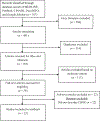A systematic review of components of community-based organisation engagement
- PMID: 29314373
- PMCID: PMC6124309
- DOI: 10.1111/hsc.12533
A systematic review of components of community-based organisation engagement
Abstract
Community-based organisations (CBOs) are important for eliminating health disparities globally and translating research findings to inform interventions. Engagement is an integral part of partnerships between CBOs and community health researchers and impacts the quality and quantity of any desired outcome. Despite the acknowledged benefits of community-based organisation engagement (CBOE), there are variations in its operationalisation and paucity in the understanding of its use in community-scientific partnerships. To further understand CBOE, the aim of this study was to synthesise published literature relevant to the definitions and applications of CBOE and identify its key components. A systematic search was conducted in March 2017, and updated in June 2017. Keywords were varied to account for international differences in spelling and word usage. Five major databases, MEDLINE, PubMed, CINAHL, PsycINFO and Google Scholar, were used to identify potential research studies. A total of 32 studies were included in this review. Following the analysis of the literature, four salient themes emerged as components of CBOE: (1) Need (a consensus between all the parties in a partnership on the importance of a specified project and its proposed benefits to a target community); (2) Partnership Dynamics (the workings of a relationship between a CBO and a scientific/academic stakeholder); (3) Resources (include but are not limited to: personnel, money, work space, expertise and equipment); and (4) Outcomes (products of the partnership). This review provides a foundation for future research in applying CBOE to translational research and interventions. This analysis will assist community health researchers in planning partnerships with CBOs, and make necessary adjustments to improve study outcomes. Appropriate application of the components of CBOE in partnerships will assist researchers in addressing health disparities.
Keywords: community engagement; community-based organisation; community-based organisation engagement; community-based organization; community-based participatory research; translational research.
© 2018 John Wiley & Sons Ltd.
Conflict of interest statement
CONFLICTS OF INTEREST
No conflicts of interest have been declared.
Figures
References
-
- Akintobi TH, Yancey EM, Daniels P, Mayberry RM, Jacobs D, & Berry J (2012). Using evaluability assessment and evaluation capacity-building to strengthen community-based prevention initiatives. Journal of Health Care for the Poor and Underserved, 23(2 Suppl), 33–48. 10.1353/hpu.2012.0077 - DOI - PMC - PubMed
-
- Bloom T, Wagman J, Hernandez R, Yragui N, Hernandez-Valdovinos N, Dahlstrom M, & Glass N (2009). Partnering with community-based organizations to reduce intimate partner violence. Hispanic Journal of Behavioral Sciences, 31, 244–257.
Publication types
MeSH terms
Grants and funding
LinkOut - more resources
Full Text Sources
Other Literature Sources


